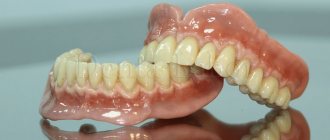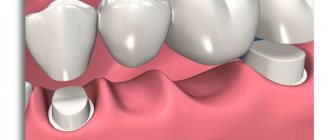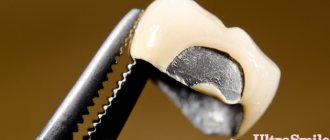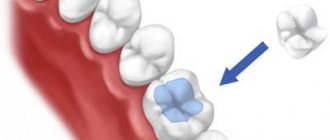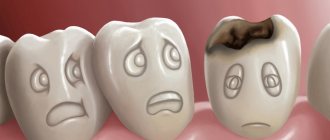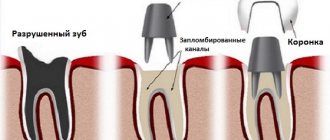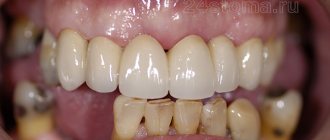When is this procedure used?
It is necessary to prepare the tooth for a stamped crown. It is important to do this so that it fits perfectly to the tooth surface. To this end, it is important to observe the following rules:
- grind off the convex parts of the tooth when they plan to install a cast crown on it, so that the installation is easy and without consequences;
- take into account the thickness of the future prosthesis so that it does not cause discomfort;
- When processing, it is important to carefully remove the affected tissue, so the structure will last a long time and the patient will be protected from secondary caries.
Making crowns
The production of stamped crowns includes two main stages:
- Clinical – the work is performed by an orthopedic dentist with the participation of the patient.
- Laboratory – here the technician is already connected.
It all starts with preparation - the tooth is prepared for a stamped metal crown, resulting in a stump. After this, an impression is made from the upper and lower jaws. Then a technician gets involved in the work and, in a laboratory setting, uses the impressions received to form plaster models of the jaws. In this case, the position of the central bite is determined, for which a special device is used - an occluder.
Next, using a plaster model, the technician uses wax to recreate the anatomical shape, from which a plaster stamp is then cut, and then from a light metal alloy. After this, the sleeve is selected to give the required shape. Finally, the crown itself is stamped and sent to the dentist for installation.
Peculiarities
Let's consider the main features of preparation:
- It is important to start work from the side surfaces so that the adjacent teeth are not damaged; approximately 0.3 millimeters of the surface is removed.
- When installing a metal-ceramic crown, the nerve of the tooth must be removed. Then it is processed and a ledge is made.
- The margin for the porcelain crown should be approximately 0.1 millimeter, and the stump should be shaped like a cone or cylinder.
- For a crown made of plastic, processing is also done similar to that for a porcelain product.
- The ledge for a stamped crown should be from 0.2 to 0.3 millimeters, while the tooth is given the shape of a cylinder. How thick the tooth will be is individual for each patient.
Possible mistakes
No one is immune from making mistakes; the human factor can affect any area of human activity, and dentistry is no exception. And since this area deserves increased attention, it is necessary to try to minimize all possible risks. However, errors may occur.
There are cases when a crown is not placed on a treated tooth, although the preparation for a stamped crown was performed efficiently and in accordance with all requirements. In this case, the issue is most likely due to an incorrect print. It will not be possible to deliver the products in any way; the crown must be made again.
Those products that are also subject to alteration are:
- fit freely onto the tooth;
- do not contact nearby units;
- when closing, the antagonists are not reached;
- does not reach the gum tissue more than 0.1 mm.
Mistakes at the crown fixation stage can ultimately result in complications. And this is not only decementation, but also the development of dental diseases.
How does turning happen?
At the very beginning of the procedure, the patient is given anesthesia. If work with vital teeth is meant, anesthesia is not used, except in cases where it is necessary to move the gums back using a special thread.
It is best to take an x-ray before the procedure. With its help, the dentist will see all the structural features of the dental organs and possible deviations.
It is also important to take into account the anatomical features of the patient’s teeth and the response of soft tissues to the preparation procedure.
How long are crowns designed for?
Despite the fact that stamped crowns have a very affordable price, but perhaps for this reason, these products are designed for a relatively short service life - 2-3 years. But dental experts recommend changing them a little more often, at least once a year.
Usually, after preparing for a stamped crown, during this time a gap will form between the crown and the tooth, where food particles can get in. As a result, this negatively affects the structure of the tooth.
In any case, the final service life depends on the characteristic and individual characteristics of the patient and on how responsibly he approaches the care of crowns.
What materials are used?
They make stamped structures from metal. They can be coated or not. Noble materials are usually used as sputtering: silver and gold. Gold is used much more often.
In Soviet times, stamped crowns were mainly used without spraying, and the demand for them was significant.
Today, products obtained by stamping are used by patients with small financial resources. After all, they cost much less than ceramic and porcelain structures.
Material of manufacture
As a rule, the production of crowns by stamping is carried out using metal, both with and without spraying. The surface layer is usually formed from a noble material - gold or silver. Gold plating, for obvious reasons, is in much greater demand. Although previously crowns were relevant without spraying.
Today, only those people who have a limited budget can install stamped crowns. This is due to the fact that all other analogues made of high-quality plastic or ceramics are not cheap.
Preparation methods for a solid crown
Today, dentists use the following types of grinding:
- grinding using ultrasound;
- laser processing;
- tunnel preparation for a stamped cap;
- air-shaped method;
- chemical treatment.
Let's look at the features of each method:
- Ultrasonic grinding has such positive aspects as minimal pressure exerted on dental tissues, the tissues do not overheat, because minimal heating is observed during the procedure, the procedure is painless, chips and cracks do not form on the pins, and there is no adverse effect on the pulp.
- Laser processing involves the use of pulsed lasers. The procedure is silent, safe, goes quickly enough, the tooth tissue does not heat up, there is no pain, there is no risk of infection, the pins are not susceptible to chips and cracks.
- Tunnel processing involves regulating the speed of work carried out thanks to special installations. You can use different tips. It is very important that the equipment used is in proper order, because the result of the treatment depends on it. When using a worn-out instrument, the tissues can overheat, leading to further destruction of the dental organ. An important advantage of this technique is that you can control the amount of layer that needs to be removed. It is important to apply anesthesia before the procedure to avoid pain. There is a risk of injury during operation.
- The air-shaping method of preparation is quite simple, quick and absolutely painless. There is no effect on the nerve bundle. It is also important that with this method of tooth treatment, most of its living tissue is preserved.
- Chemical treatment involves the use of special chemicals that soften damaged tissue. The disadvantage of this method is its sufficient duration of treatment. This type of treatment is especially often used for children. The advantages of this treatment are the absence of thermal tissue burns, pain, minor injuries and psychological discomfort, because the drill, which many patients are terrified of, does not work.
What is tooth preparation
As part of the procedure, the specialist grinds down the hard tissues of the tooth in order to achieve a flat and smooth surface suitable for fixing a crown or orthopedic structure. Only the tightest possible contact between living and artificial tissue provides reliable protection of the enamel from injury, and also guarantees the strength of the product’s fixation.
In addition, the tooth is given a certain shape that exactly replicates the internal cavity of the crown. This allows you to fix the prosthesis more tightly and accurately.
Tooth preparation
If earlier this procedure was quite lengthy and quite painful, now before it is performed the patient is given an injection with an effective local anesthetic. Modern methods of pain relief guarantee absolute painlessness and a high level of comfort for the patient.
Turning methods
- tunnel turning: the classic use of a drill using a metal or diamond tip. The device operates in various speed modes, but at very high speeds, so to prevent overheating of the tissues, a stream of cold water must be supplied. The technique allows grinding down any amount of living tooth tissue,
- ultrasound: this method involves the use of a special device that transmits high-frequency vibrations. In this case, the instrument does not come into direct contact with the enamel, thereby reducing the risk of injury to dentin and nerves. The procedure is completely painless and safe, but allows for the preparation of only a small amount of dental tissue,
- laser: the procedure does not pose any threat to health and allows you to achieve the desired result in the shortest possible time. This method refers to non-contact methods of grinding teeth, so the risk of damage to the pulp is minimized. True, it is also used when removing small amounts of dental tissue,
- air-abrasive preparation technique: the method involves exposure to water with a mixture of abrasive particles, as a result of which hard tissue is ground down to the desired shape and size. In this case, the patient does not experience pain. This method allows you to preserve as much healthy tissue as possible, and also eliminate the risk of chips and cracks after turning,
- chemical method: here they use acids that can quickly and reliably destroy hard tissue. After exposure to the composition, the specialist removes the softened areas and creates the desired shape. This is a rather lengthy procedure, and also very outdated.
When is the preparation performed?
Currently, there are several main types of dental preparation, depending on the type of structure that is planned to be installed to restore the aesthetics and functionality of the dentition:
- veneers: surface treatment for veneers is carried out using a special technology. At the first stage, the specialist works on the front side, after which he gradually moves on to the side surfaces. Only in rare cases is it necessary to prepare the anterior teeth in the palatal area or the incisal edge. As a rule, horizontal and vertical groove stripes are created on the enamel, in which dental glue will be located,
- inlays: partial dentures that are used to hide minor defects. In order to securely fix such a product, the side walls are prepared parallel to each other1. This form makes it possible to easily and quickly install the structure at the required depth,
- crowns and bridges: a crown is an artificial top that protects the tooth from the development of carious lesions, prevents infection of weakened tissues, and also allows you to restore aesthetics to your smile and restore full functionality. Grinding is required for metal-ceramic crowns, cast metal, porcelain, zirconium, ceramic and plastic solutions, as well as for bridges, except for adhesive bridges - their installation does not require additional grinding of some tissues,
- splinting: this procedure involves fixing mobile teeth in the correct position using pin, beam or inlay splints. In this case, it is necessary to remove a minimum amount of enamel, but in some situations depulpation may also be required.
“Relatively recently, I went through all the stages of installing metal-ceramic crowns, including preparation. During the procedure I did not feel any pain at all. The doctor gave an injection of anesthesia in advance, so everything went well.
But the sensations themselves are of course very unpleasant, and then there’s this terrible roar of the boron! I still don’t know whether this was a medical error, but after grinding my dead tooth suddenly turned pink! In general, I was given temporary crowns first, and then metal-ceramics.
I really hope they last a long time!”
Marina, 47 years old, from correspondence on a thematic forum
Complications and pain after turning
If the quality of the procedure is poor, there is a risk that the patient’s tooth cavity will subsequently open.
Even if the preparation was carried out as carefully as possible, the pulp is in any case subjected to a certain impact, as a result of which the vessels dilate and swelling occurs.
Immediately after grinding, no pain is felt, however, when the effect of the painkiller wears off, discomfort appears and the gums become inflamed.
According to practicing experts in the field of prosthetics, if a vital tooth was subjected to preparation, that is, with the pulp not removed, above which only a thin layer of dentin remained, then after turning the tooth will react to the cold and cause some discomfort. Therefore, specialists resort to temporary structures or cement the worn-out area until a permanent solution is installed.
Sometimes during the procedure, the doctor has to slightly push back the gums using a special thread, which entails compression of the soft tissues and provokes the development of swelling and pain.
What to do if your gums hurt after grinding? As a rule, the discomfort goes away on its own after a few days. In this case, the doctor can immediately suggest the best way to rinse your teeth after grinding in order to relieve acute symptoms.
If quite a lot of time has passed after the procedure, but your teeth still hurt, you should seek help from a specialist.
Pushing back gums with floss
Types of ledges
Grinding of teeth is carried out strictly according to certain rules, with short breaks (to prevent tissue overheating). Immediately after the procedure, temporary crowns or fillings are installed on the treated living teeth. During the preparation process, a specialist can form the following types of ledges:
- knife-shaped: the widest of all, therefore suitable for crowns that have a thick layer of tissue, namely all-metal or metal-ceramic crowns,
- grooved: the rounded shape in this case makes it possible to preserve the maximum volume of living tissue. The width can vary from 0.8 to 1.2 mm. This option is ideal for metal ceramics,
- humeral: this type of ledge with a width of 2 mm requires depulpation. However, this option can significantly increase the strength of the crown fixation and provide higher aesthetic characteristics2.
Features of the procedure in childhood
When working with baby teeth, dentists try to avoid unnecessary procedures that may pose a certain threat to the condition of the child’s thin enamel. In addition, any additional manipulation using a noisy drill usually results in serious stress for the child.
As a rule, experts offer alternative and more gentle treatment methods that do not require preliminary preparation.
In this case, pediatric dentistry is focused on protecting the not yet fully formed enamel from any type of injury. However, there are situations when turning for a crown is indispensable.
Most often, preference is given to the chemical method, as it is less painful. Usually it is enough to remove only the tissue affected by caries.
Without turning - alternative methods of prosthetics
- removable prosthetics: the most cost-effective and fastest option for restoring the integrity of the dentition. In this case, the structure can be fixed using a special fastening system on the supporting teeth or even in the absence of all of them in the oral cavity. In this case, no turning of supporting elements is required,
- conditionally removable prosthetics: in this case, tooth roots are used to fix the system, which must be in excellent condition. During the installation of the prosthesis, they are strengthened using special pins with a small lock. When installing the prosthesis, the lock automatically snaps into place and the system is securely held in the mouth,
Clasp dentures with locks - adhesive bridge: to fix such a structure, the presence of two supporting elements is necessary, but they are not subject to preparation. Along the edges of one or more artificial crowns there are special plates that allow you to fix the system by attaching it from the inside using dental glue,
- implantation: this treatment method involves replacing not only the crown, but also the root, which allows you to restore the anatomy and return the full functionality of the entire dental system. In this case, the implant, which acts as a root, is installed inside the bone tissue, and then a crown or any other orthopedic structure is put on it.
What types of ledges are there?
The main condition for attaching a crown to a tooth is its grinding with a ledge.
The absence of a ledge violates the standards of prosthetics, because in this case there will not be the necessary tight fit of the crown to the dental organ, which can lead to serious complications.
The ledges vary depending on the type of crown. Let's look at the main types of ledges:
- Knife-shaped is the most common type. Its width is 0.3-0.4 millimeters. Used when preparing for a solid cast structure, as well as when grinding inclined teeth.
- A rounded grooved ledge 0.8-1.2 millimeters thick is made under the metal-ceramic crown.
- The most expensive preparation is with a shoulder ledge. In this case, the dental nerve must be removed. The width of such a ledge is exactly two millimeters. With it, the crown is attached most tightly, and the artificial tooth looks more aesthetically pleasing.
Price issue
How much could such a pleasure cost? The cost of crowns is influenced by the composition and external coating. The metal product will cost patients 1500-1600 rubles. For spraying you will have to pay a little more - 1700-1800 rubles. Cladding made of plastic material will cost a little more - 1900-2000 rubles. And if the crown is made with lining and spraying, then the amount can reach up to 2100 rubles.
It’s just worth noting that dental clinics offer their own prices for the preparation procedure for various types of crowns. As a rule, in the regions the cost can range from 1000 to 1300 rubles, while in Moscow clinics you will have to pay at least 1500-2500 rubles for such prosthetics.
Not all dentists prefer to deal with this type of prosthetics, which is explained by their low “return”, but transportation is also included in the costs. In many ways, these are elite-class dental clinics.
Nuances during manufacturing and installation
Let's consider the basic rules that are important to follow when manufacturing and installing stamped structures:
- After installation, the crown should fit snugly to the tooth surface. With a wide product, irritation and pushing back of the gum tissue, as well as its atrophy, are possible. But there will still be a gap between the tooth and the crown, so it is filled with a special cement composition that gradually dissolves over time.
- The product should not go into the groove more than 0.3 millimeters. With greater immersion, the formation of an acute form of marginal periodontitis is possible.
- The product must completely restore both the chewing function of the dental organ and its full functionality.
- It is important that the crown adheres to all the anatomical features of the tooth. All hillocks and equators must be present.
- When contacting the opposite tooth, it is important that the interalveolar height is not exceeded, otherwise injury may occur.
Does the patient feel pain during treatment?
Tooth grinding takes place under anesthesia, so there is no pain. But when the anesthesia stops working, pain may be felt both in the tooth and in the gum.
Causes of pain:
- when too much cover is removed;
- when the gums are pulled back (a special thread is used), the tooth may hurt for a couple of days;
- If pain is detected some time after the treatment procedure, an inflammatory process may begin in the tooth.
Stages of prosthetics
Like any dental procedure, prosthetics with solid crowns is implemented in several stages:
- Inspection and assessment of the condition of the oral cavity, disinfection of necessary areas.
- Obtaining an imprint of the tooth and the dentition itself using silicone. During the period during which the structures will be made, the patient is given temporary crowns, which make it easier to get used to the permanent ones.
- Making a crown in a dental laboratory.
- Fixation in the oral cavity. In this case, the end of the crown should be minimally immersed in the gum and not cause much discomfort.
Contraindications
Note: Contraindications to the use of stamped products are: bruxism, increased tooth abrasion, severe destruction of the tooth crown or subgingival destruction, foci of chronic infection of periapical tissues.
Stamped crowns are not much different from other prostheses. They must meet the following requirements:
- restore a tooth, taking into account all its anatomical properties;
- fit tightly to the dental neck of the tooth and descend into the groove between the tooth and gum no more than 0.2-0.3 millimeters;
- restore contacts with adjacent and opposite teeth.
For the manufacture of stamped structures, stainless steel sheets are used. Cylinder-shaped caps of different diameters (sleeves) are stamped from them.
Composite compounds and plastics are also used to modify stamped products.
Positive and negative qualities
The advantages of stamped products are:
- Low cost, significantly lower than the price of metal-ceramic products and approximately similar to the price of plastic products.
- Simplicity of design.
- Short production times.
- Possibility of use in cases in which the use of other prosthetic methods is complicated.
Negative qualities:
- The cement that holds the crown in place dissolves over time.
- Caries may develop if the crown does not fit tightly to the dental organ, and pieces of food accumulate in the gap formed.
- The alloy used for manufacturing is not particularly strong, so the crown is gradually subject to abrasion.
- Lost tooth functionality is not fully restored.
How to care for such crowns?
When a stamped crown is installed, the patient must follow all basic rules of oral hygiene as usual. The most important thing is to do this regularly and thoroughly.
Main care features:
- You need to brush your teeth twice a day using a brush and toothpaste;
- After every smoking and eating food, including snacks, it is important to rinse your mouth or brush your teeth;
- To remove food debris from the interdental spaces, dental floss is used.
It is important to remember that 3 months after installation of the prosthesis, you need to visit a doctor who will examine and evaluate the condition of the product. Then visits to the dentist should be made regularly every three months to avoid complications, for example, the appearance of caries under the crown.
List of contraindications
Dental preparation procedures are not recommended for children before reaching adulthood, since tissue formation and growth occurs during this period of their lives. And it is highly undesirable to interfere in any way with this process. There are also other cases:
- If the dental canal is treated poorly.
- Inflammatory process of pulp and periodontium in the chronic stage.
- High degree of tooth mobility.
Also, you should not begin preparation for a stamped metal crown in patients with bruxism (involuntary grinding of teeth).
